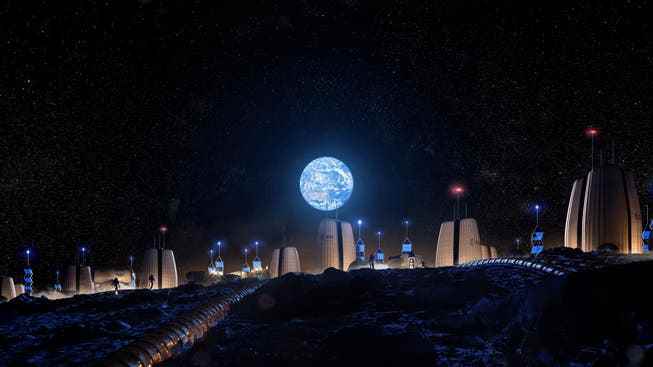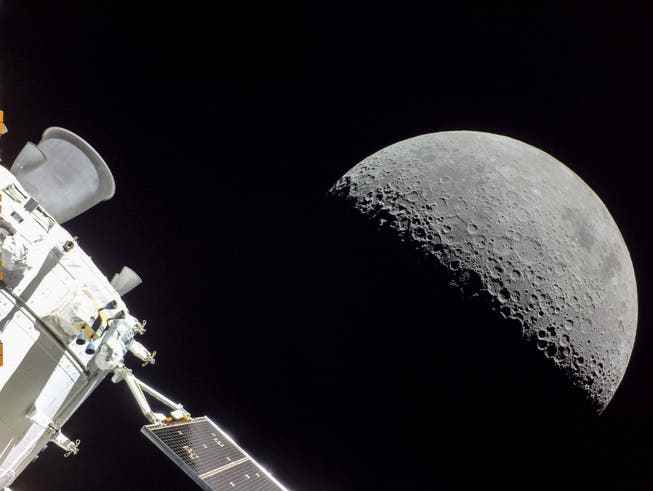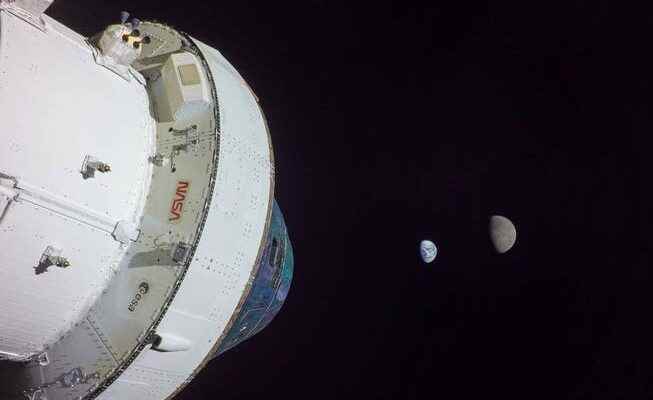NASA’s lunar program cleared the first hurdle. In the next few years, astronauts are to land on the moon and prepare for later colonization. But the US is not the only country with such plans.
Earth and moon from an unusual perspective. The picture was taken while orbiting the moon.
After around four weeks in space, the unmanned “Orion” capsule of NASA’s “Artemis 1” moon mission is back on earth. The capsule landed in the Pacific off the coast of Mexico on Sunday evening, as shown in live images from the American space agency Nasa. With the help of specialists, divers and boats, “Orion” is now to be brought to the port of San Diego.
After almost a month in space, it was the last major test for “Artemis 1”: According to NASA, “Orion” flew into the earth’s atmosphere at around 40,000 kilometers per hour and was then slowed down to around 480 kilometers per hour. The heat shield of “Orion” had to withstand temperatures of around 2800 degrees Celsius. With the help of parachutes, “Orion” was then further slowed down to around 32 kilometers per hour and landed in the sea.
The goal is to colonize the moon
With the successful Artemis 1 mission, the USA opened a new chapter in manned space travel. After more than 50 years, America wants to go back to the moon – and unlike the Apollo missions, this time it shouldn’t just be about occasional visits. Rather, the USA, together with its international partners, want to settle permanently on the Earth’s satellite and lay the foundation for a “lunar economy” here.
China and Russia are also pursuing similar plans. And countries that have not yet been among the leading space nations have launched programs to explore the moon. They all want to have a foot in the door when things get serious about colonizing the moon.
At the moment it is difficult to imagine that settlements will be built, raw materials mined, goods manufactured or tourists entertained on the moon. But that could change in the coming decades.
So appreciates The accounting firm PricewaterhouseCoopers (PwC) predicts that a $170 billion lunar market could emerge by 2040. The transport of goods and astronauts in particular could develop into a lucrative business for private space companies. According to PwC, the transportation sector has a potential market volume of $80 billion.
According to PwC, the driver of this development is the USA. With its Artemis program, NASA has presented the most concrete plan of all countries for colonizing the moon. Above all, the USA has done a lot to boost the lunar economy with the “Commercial Lunar Payload Services” program.
This program has a volume of 2.4 billion dollars and supports companies that develop scientific instruments, landing units or even small rovers for the moon on their own. The robotic missions serve to prepare a future colonization of the moon. For example, they should measure the radiation exposure on the moon or find out whether there is frozen water under the surface and other resources that are essential for survival on the moon. The first payloads are scheduled to land on the moon in 2023.
In principle, NASA could have developed these robotic missions itself. However, the American space agency is cheaper if it puts these tasks in private hands and lets the competition play their part. This model has proven itself in near-Earth space. Today it is companies like SpaceX or Orbital Sciences Corporation that supply the International Space Station (ISS) with cargo on behalf of NASA. Private companies are now even responsible for transporting astronauts to the ISS. Nasa is just a customer.
The next steps up to a lunar base
Meanwhile, NASA can concentrate on the big tasks. The next step after the successful Artemis 1 mission is a manned orbit of the moon. It is scheduled for 2024. But it is questionable whether NASA will be able to get a second rocket and a second spacecraft ready for launch by then. Many space experts doubt this and do not expect a launch before 2025.
This would probably also postpone the Artemis 3 mission planned for 2025, which is intended to bring astronauts to the moon again for the first time. They are supposed to land near the South Pole. A moon base is also to be built there later. Because at the south pole of the moon there are deep craters into which a ray of sunshine never falls. Consequently, there could be ice there from which drinking water and oxygen could be extracted.
For the Artemis 3 mission, NASA is dependent on the help of SpaceX. The private space company is developing the lunar module on behalf of NASA, which is to bring two astronauts from the Orion capsule to the moon and back six days later. The lunar module is a descendant of the Starship, with which Elon Musk wants to fly to the moon and later to Mars independently of Nasa.
What happens next depends on how quickly NASA, ESA, the Japanese and Canadian space agencies progress with the construction of the Lunar Gateway. It is a space station consisting of several modules that orbits the moon. As on the International Space Station, scientific experiments are to be carried out here. At the same time, the Lunar Gateway also serves as an intermediate station. Goods, fuel, rovers and astronauts are brought to the moon from here. The first module is scheduled to be deployed in lunar orbit in 2024.
If the construction of the Lunar Gateway progresses quickly, there should be another landing on the moon every year after the Artemis 3 mission. There is not enough money for more. Because every start cost NASA $4.1 billion. Step by step, the three parts of the lunar base are to be built near the South Pole: accommodation for the astronauts, a rover for short trips, and a pressurized rover in which the astronauts do not have to wear space suits and can therefore go on longer trips.
Opposite the BBC NASA executive Howard Hu recently said astronauts would be working at Lunar Base Camp for long periods before 2030. Hu did not specify what “longer” means. Either way, he leans far out of the window. Nasa is already behind schedule with its Artemis program. And it shouldn’t be surprising if more delays pile up in the coming years.
China also wants to build a lunar station by 2035
The US and its partners are not the only ones who have chosen the south pole of the moon as a base. China has also announced that it intends to build a manned station there by 2035. China wants to cooperate with Russia, but is also open to cooperation with other countries.
The successful Chang’e 4 mission underscores the fact that China’s ambitions should be taken seriously. In 2019, China was the first country ever to land softly on the far side of the moon and set down a rover there. This mission has earned the country worldwide respect. China is also the only country after the US and Russia to have brought samples from the moon to Earth.
China is planning more robotic missions in the coming years. One of them leads to the South Pole. There, a rover and a flying probe are supposed to be on the lookout for ice and other resources. Even if the Chinese plans for the construction of a manned moon base are not yet very concrete, these explorations serve as preparation.
Ironically, China is envisaging some of the same landing sites for its robotic mission to the South Pole as NASA for the manned Artemis-3 mission. This is because there aren’t many places on the moon that are close to deep, shadowed craters while still offering good lighting conditions. A first conflict over lunar resources is looming here. How China and the USA resolve this conflict could be groundbreaking for the future colonization and use of the moon.
The vision of the global village on the moon

A beautiful vision: a global village on the moon.
The former Director General of ESA Jan Wörner once had the visionthat a kind of global village will emerge on the moon. There, all nations should be able to develop freely and pursue their respective interests in partnership, be they scientific or economic. All differences of opinion that exist on earth should be overcome on the moon.
Today, only seven years later, this vision no longer seems very realistic. Because of the war in Ukraine, cooperation between Russia and the US on the International Space Station is working poorly. The relationship between China and the USA is also tense. NASA administrator Bill Nelson recently accused China of to use space for military purposes and not to share scientific knowledge. How the moon can be used jointly under such conditions is a mystery.

